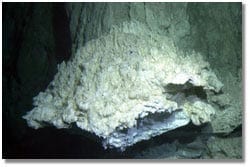WHOI Scientists and Engineers Explore “Lost City” in the Atlantic
July 29, 2005
Biologist Tim Shank of the Woods Hole Oceanographic Institution (WHOI) is “at sea” once again studying marine life at the bottom of the ocean, but this time it is via television monitors in real time from the comfort of a shore-based facility thousands of miles away. Shank and most of the researchers investigating the Lost City hydrothermal vent field, about 2,500 feet below the surface of the Atlantic Ocean, are ashore in a classroom outfitted as a command center at the University of Washington (UW) in Seattle.
Chief Scientist for the cruise, Deborah Kelley of UW, and the other researchers from more than six research institutions are able to direct sampling efforts and be in constant communication with four scientists, students, remotely operated vehicle pilots and other team members on the NOAA vessel Ronald H. Brown. Oceanographer Robert Ballard is co-chief scientist with Kelley and is leading the efforts at sea.
The expedition marks the return to the Lost City vent field discovered in 2000 during a National Science Foundation cruise about the WHOI research vessel Atlantis. The vent field is on top of an underwater mountain the size of Mt. Ranier, called the Atlantis Massif, on the Mid Atlantic Ridge about 3,000 miles east of Florida. It is named for WHOI’s first research vessel and the vessel of the same name that discovered the vent field. The Mid-Atlantic Ridge is part of an underwater chain of mountains known as the mid-ocean ridge system that circles the Earth for 40,000 nautical miles. The ocean crust here is about 1.5 million years old, and scientists believe the Lost City field has been active for thousands of years. There are more than 30 active and inactive chimneys in the field, which is about 1,300 feet long and 1,000 feet wide at a depth of about 2,500 feet. Some of the chimneys are very small and others 60 to 100 feet tall. The largest structure is about 18 stories, or 200 feet, tall and is unlike any found at other vents.
Hydrothermal vents were discovered in 1977 on the Galapagos Rifts in the eastern Pacific, part of the mid-ocean ridge system where the great crustal plates of the Earth are in constant motion and new ocean crust is formed, often by magma reaching the ocean floor. Black smokers spewing superheated water more than 700 degrees Fahrenheit were found on the East Pacific Rise south of Baja California in 1979. But the Lost City vent field is different. It is based on heat as seawater reacts with rocks below the field, not on volcanism, and the fluids are much cooler and nearly 100 percent carbonate, like limestone found in caves, ranging in color from white to gray.
Shank was part of the original expedition, as are most of the scientists involved in the current cruise, which began July 23 and ends August 4. He has studied hydrothermal vents in the Atlantic, Pacific and Indian Oceans, looking at the evolution of animals between oceans. Unlike other vents, where animals can be many feet long or the size of dinner plates, most of the animals at the Lost City vents are very small, less than a half-inch with translucent or invisible shells. Shank wants to know if they are unique to Lost City or if they are found at other vent systems around the world.
Other WHOI staff on the expedition include engineers from the Deep Submergence Laboratory, graduate students and postdoctoral fellows. All the WHOI researchers except for Shank are among the 31 expedition members at sea.
“This has been a very interesting experience,” Shank says. “I was a college student when Bob Ballard, then a scientist at WHOI and a member of the teams that found the hydrothermal vents and black smokers in the late 1970s, first suggested the idea of telepresence, taking people to sea remotely but in real time. He and WHOI colleagues demonstrated that vision with the first JASON Project in 1989, enabling students to drive the remotely operated vehicle JASON in real time via satellite and sharing the excitement of exploration with the public at museums and science centers. Scientists were able, for the first time, to direct sampling in real time from the command center at WHOI. I heard those stories, and now I am participating in the realization of that vision on a much bigger scale.”
Shank says he is anxious to study the samples collected at sea, and to talk with his colleagues who experienced first hand the expedition at sea. “We have come a long way since conducting the telepresence of 1989. This expedition has demonstrated that telepresence technology is now providing magnificant opportunities to include many more scientists, students and the public in first hand exploration of the sea. Conducting in-depth scientific investigations through remote research teams will require more time and experience to reach its full potential. There is no doubt that telepresence is clearly an exciting way to bring the global public to explore the depths of our oceans. This is an extremely exciting time in ocean exploration.”
Major partners in the expedition are the National Oceanic and Atmospheric Administration, University of Washington, University of Rhode Island, Institute for Exploration, Jason Foundation for Education, Immersion Presents, and the National Geographic Society. Immersion Presents broadcasts are being seen at select Boys and Girls Clubs, aquariums and museums.
The public can follow the Lost City voyage at:
http://www.oceanexplorer.noaa.gov
http://www.immersionpresents.org or
http://www.Jason.org/lostcity

